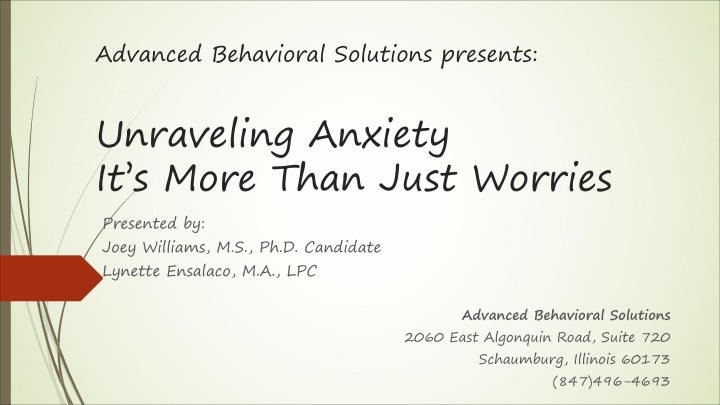



Advanced Behavioral Solutions presents: Unraveling Anxiety It’s More Than Just Worries Presented by: Joey Williams, M.S., Ph.D. Candidate Lynette Ensalaco, M.A., LPC Advanced Behavioral Solutions 2060 East Algonquin Road, Suite 720 Schaumburg, Illinois 60173 (847)496-4693
What is Anxiety Anxiety is the body’s natural response to stress. It is adaptive – designed to help us escape dangerous situations … but sometimes it can become “over-active”
Neuropsychology of Anxiety Understanding the brain/body connection Fight, Flight, Freeze response
When Does Anxiety Become a Disorder When there is a significant negative impact on daily functioning, it is no longer considered typical anxiety Typical Anxiety vs. Clinical Anxiety Helpful vs. Harmful Manageable vs. Uncontrollable Time-limited vs. Constant
Types of Anxiety Generalized Anxiety (GAD) Obsessive Compulsive Disorder (OCD) Phobias Social Anxiety Selective Mutism Separation Anxiety Performance Anxiety Panic Disorder Trauma Related Anxiety
Symptoms of Anxiety
Symptoms of Anxiety Crying Reassurance seeking Clinging to caregivers Asking “What if” questions constantly Avoidance/Refusal behaviors Physical complaints Anger Sleep problems Restlessness/Agitation Overthinking/Racing thoughts Expresses worries or fears Getting stuck/difficulty moving Meltdowns on (Rumination) Attempting to be in control
Children Crying Reassurance seeking Clinging to caregivers Asking “What if” questions constantly Avoidance/Refusal behaviors Physical complaints – Anger stomachache, headache, nausea, etc. Restlessness/Agitation Sleep problems Expresses worries or fears Overthinking/Racing thoughts Meltdowns Getting stuck/difficulty moving Attempting to be in control on (Rumination)
Adolescents/Teens Crying Reassurance seeking Physical complaints – Clinging to caregivers stomachache, headache, Avoidance/Refusal behaviors shakiness, sweating, racing Anger – Irritability heart Restlessness/Agitation Sleep problems Expresses worries or fears Overthinking/Racing thoughts Meltdowns Getting stuck/difficulty moving on (Rumination) Attempting to be in control
Young Adults Crying Reassurance seeking Physical complaints – headache, Clinging to caregivers tension, shakiness, sweating, Avoidance/Refusal behaviors racing heart Anger Sleep problems Restlessness/Agitation Overthinking/Racing thoughts Expresses worries or fears Getting stuck/difficulty moving Meltdowns on (Rumination) Attempting to be in control
Symptom Development Functional/developmental level will influence which symptoms are present Development of insight can significantly change symptom presentation Common co-occurring disorders Rule-out disorders
What Can Parents Do?
Preventative Approaches Providing daily structure and use of routines are helpful Knowing what to expect Pre-teaching Going over expectations and helpful coping skills before a potential problem
Keep Your Cool Be a model of how to handle stress and problem solve Be aware of your - Volume Tone of voice Talking speed Body language
Build Your Child’s Confidence Your child needs to believe that you believe in them It is important that you believe in their ability to try , not necessarily that they will succeed every time Find a balance between being helpful vs. enabling Enabling behaviors feed into the anxiety, making it worse over time Providing reassurance repeatedly – once or twice is enough, then encourage your child to reassure themselves Encourage them to try to do things on their own before asking for help
Ask For Help Build a support team for you and your child Professional support Psychotherapy/counseling ( Individual and Group) School support Anxiety that is impacting a student’s success can qualify them for formal accommodations (Section 504 Plan or IEP) Family/Friend support *Communication should be open among all people
Resources Worried No More: Help and Hope for Anxious Children by Aureen Pinto Wagner, Ph.D. Helping Your Anxious Child: A Step-by-Step Guide for Parents What to Do When You Worry Too Much by Dawn Huebner, Ph.D. Outsmarting Worry: An Older Kid’s Guide to Managing Anxiety by Dawn Huebner, Ph.D. Freeing Your Child from Anxiety: Powerful, Practical Solutions to Overcome Your Child's Fears, Worries, and Phobias by Tamar Chansky, Ph.D. The Anxiety and Phobia Workbook by Edmund Bourne, Ph.D. The Anxiety Workbook for Teens: Activities to Help You Deal with Anxiety and Worry by Lisa M. Schab, LCSW YouTube/Podcast – AT Parenting Survival for All Ages by Natasha Daniels
Recommend
More recommend